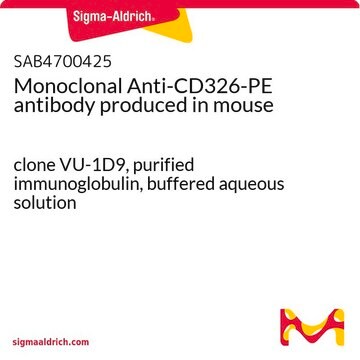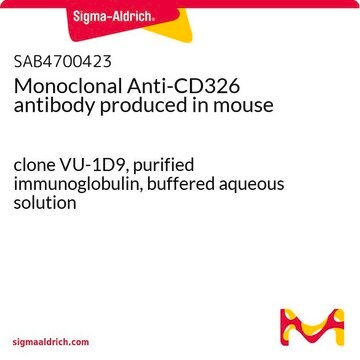推荐产品
生物源
mouse
共軛
FITC conjugate
抗體表格
purified immunoglobulin
抗體產品種類
primary antibodies
無性繁殖
VU-1D9, monoclonal
形狀
buffered aqueous solution
物種活性
human
技術
flow cytometry: suitable
同型
IgG1
NCBI登錄號
UniProt登錄號
運輸包裝
wet ice
儲存溫度
2-8°C
目標翻譯後修改
unmodified
基因資訊
human ... EPCAM(4072)
相关类别
一般說明
Epithelial cell adhesion molecule (EpCAM) or cluster of differentiation 326 (CD326), is encoded by the 14kb GA733-2 gene mapped to human chromosome 2p21. Human CD326 expression is restricted to epithelia of colon, small intestine, lung, kidney, thymus, liver, pancreas, stomach. It is also expressed in several cancers, progenitor and stem cells. CD326 is a transmembrane glycoprotein characterized with an ectodomain, one transmembrane domain and a 26 residual cytoplasmic domain.
The mouse monoclonal antibody VU-1D9 recognizes an epitope within EGF-like domain I of CD326 / EpCAM, a marker of epithelial lineages. This antibody strongly stains various normal epithelial cells and carcinomas.
免疫原
Small cell lung carcinoma cell line H69
應用
The reagent is designed for Flow Cytometry analysis of human blood cells using 20 μL reagent / 100 μL of whole blood or 1e6 cells in a suspension. The content of a vial (2 mL) is sufficient for 100 tests.
生化/生理作用
Cluster of differentiation 326 (CD326) is a transmembrane glycoprotein, involved in several cellular functions, such as epithelial-specific intercellular cell–adhesion, cell signaling, migration, proliferation and differentiation. CD326 is a dominant surface antigen mapped on human colon carcinoma. It has potential as a diagnostic marker for several carcinomas, including epithelial ovarian cancer (EOC). CD326 is considered to be a potential target for cancer treatment. CD326 with the help of components of wnt signal transduction pathway plays a vital role in stem cell signaling.
特點和優勢
Evaluate our antibodies with complete peace of mind. If the antibody does not perform in your application, we will issue a full credit or replacement antibody. Learn more.
外觀
Solution in phosphate buffered saline containing 15 mM sodium azide and 0.2% high-grade protease free BSA as a stabilizing agent.
免責聲明
Unless otherwise stated in our catalog or other company documentation accompanying the product(s), our products are intended for research use only and are not to be used for any other purpose, which includes but is not limited to, unauthorized commercial uses, in vitro diagnostic uses, ex vivo or in vivo therapeutic uses or any type of consumption or application to humans or animals.
Not finding the right product?
Try our 产品选型工具.
儲存類別代碼
10 - Combustible liquids
水污染物質分類(WGK)
WGK 2
閃點(°F)
Not applicable
閃點(°C)
Not applicable
Epithelial cell adhesion molecule expression (CD326) in cancer: a short review.
Patriarca C
Cancer Treatment Reviews, 38, 68-75 (2012)
Graham Carpenter et al.
Cancer cell, 15(3), 165-166 (2009-03-03)
The epithelial-specific cell adhesion molecule (EpCAM) modulates cell adhesion and proliferation. Its overexpression correlates with tumor cell proliferation, and EpCAM is a therapeutic target. In the February issue of Nature Cell Biology, Maetzel et al. demonstrate that proliferative responses to
Monika Trzpis et al.
Transgenic research, 17(2), 229-238 (2007-10-18)
The Epithelial Cell Adhesion Molecule (EpCAM) is expressed virtually on normal epithelia in vertebrates. Among different species, the amino acid sequence of EpCAM is highly homologous, indicating that EpCAM is an evolutionary conserved protein. However, differences in the expression pattern
Gilbert Spizzo et al.
Gynecologic oncology, 103(2), 483-488 (2006-05-09)
Currently available clinical and molecular factors provide still an insufficient prognostic and predictive assessment for patients with epithelial ovarian cancer (EOC). To identify a potential molecular target and prognostic/predictive factor for EOC, we investigated in a retrospective study the prognostic
Markus Munz et al.
Cancer research, 69(14), 5627-5629 (2009-07-09)
Initially discovered as a dominant antigen on colon carcinomas, the epithelial cell adhesion molecule (EpCAM) was considered a mere cell adhesion molecule and reliable surface-binding site for therapeutic antibodies. Recent findings can better explain the relevance of EpCAM's high-level expression
我们的科学家团队拥有各种研究领域经验,包括生命科学、材料科学、化学合成、色谱、分析及许多其他领域.
联系技术服务部门








